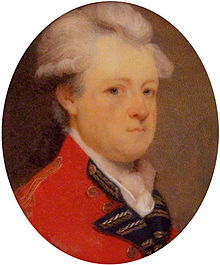William Harcourt, 3rd Earl Harcourt
| The Earl Harcourt | |
|---|---|

The Earl Harcourt
|
|
| Born | 20 March 1743 |
| Died | 17 June 1830 (aged 87) St Leonard's Hill, Berkshire |
| Buried at | Stanton Harcourt, Oxfordshire |
| Allegiance |
|
| Service/branch |
|
| Years of service | 1759–1811 |
| Rank | Field Marshal |
| Commands held | 16th Light Dragoons |
| Battles/wars |
Seven Years' War American Revolutionary War French Revolutionary Wars |
| Awards | Knight Grand Cross of the Order of the Bath |
Field Marshal William Harcourt, 3rd Earl Harcourt, GCB (20 March 1743 – 17 June 1830) was a British nobleman and British Army officer. He served as an aide-de-camp to Lord Albemarle for the expedition to Havana during the Seven Years' War. He also commanded his regiment at the Battle of White Plains and then captured General Charles Lee at Basking Ridge during the American Revolutionary War. After that he commanded the British Cavalry at the Battle of Willems during the Flanders Campaign. He succeeded the Duke of York as commander during that campaign and oversaw the British retreat and their final evacuation from Bremen. His last main military role was as Governor of the Royal Military College at Great Marlow.
Born the younger son of Simon Harcourt, 1st Earl Harcourt and Rebecca Harcourt (née Samborne Le Bas), Harcourt was commissioned as an ensign in the First Regiment of Foot Guards on 10 August 1759. He became a captain in the 16th Light Dragoons, a regiment which had been raised at his father's expense and was had been known as "Harcourt's Black Horse", on 27 October 1759. He transferred to the 3rd Dragoons on 30 June 1760 and was subsequently sent to Mecklenburg-Strelitz (with his father) to escort the consort-elect of King George III to England. In recognition of this mission he was appointed an equerry to the Queen Consort later that year.
...
Wikipedia
